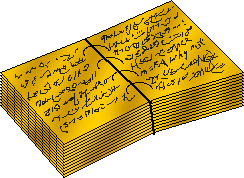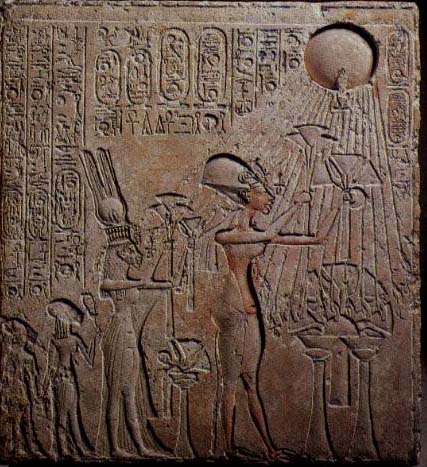Commandeur Adama
Magister Ordo Kolob - Admin

Nombre de messages : 8905
Age : 60
Localisation : Pays de Néphi - Mormon forest
Date d'inscription : 16/02/2007
Chevalier de Kolob - Vers la Sagesse
 A reçu la Lumière: 180 A reçu la Lumière: 180
 En quête du Vase Précieux et Elu: En quête du Vase Précieux et Elu:
    (150/200) (150/200)
 A la recherche du couple de Licornes du Jardin d'Eden: A la recherche du couple de Licornes du Jardin d'Eden:
    (7/700) (7/700)
 |  Sujet: Pharaoh Akhenaten Sujet: Pharaoh Akhenaten  Dim 30 Déc - 4:44 Dim 30 Déc - 4:44 | |
|
1369-1332 BC: Amenhotep IV - Akhenaten
The Pharaoh Akhenaten was known as the Heretic King. He was the tenth King of the 18th Dynasty. Egyptologists are still tying to figure out what actually happened during his lifetime as much of the truth was buried, for all time, after he died.
Akhenaten lived at the peak of Egypt's imperial glory. Egypt had never been richer, more powerful, or more secure. Up and down the Nile, workers built hundreds of temples to pay homage to the Gods. They believed that if the Gods were pleased, Egypt would prosper. And so it did.
Akhenaten and his family lived in the great religious center of Thebes, city of the God Amun. There were thousands of priests who served the Gods. Religion was the 'business' of the time, many earning their living connected to the worship of the gods.
All indications are that as a child Akhenaten was a family outcast. Scientists are studying the fact that Akhenaten suffered from a disease called Marfan Syndrome, a genetic defect that damages the body's connective tissue. Symptoms include, short torso, long head, neck, arms, hand and feet, pronounced collarbones, pot belly, heavy thighs, and poor muscle tone. Those who inherit it are often unusually tall and are likely to have weakened aortas that can rupture. They can die at an early age. If Akhnaton had the disease each of his daughters had a 50-50 change of inheriting it. That is why his daughters are shown with similar symptoms.
Akhenaten was the son of Amenhotep III and Queen Tiy, a descendent of a Hebrew tribe. The largest statue in the Cairo Museum shows Amenhotep III and his family. He and Queen Tiy (pronounced 'Tee') had four daughters and two sons. Akhenaten's brother, Tutmoses was later named high priest of Memphis. The other son, Amenhotep IV (Later to take the name Akhenaten) seemed to be ignored by the rest of the family. He never appeared in any portraits and was never taken to public events. He received no honors. It was as if the God Amun had excluded him. He was rejected by the world for some unknown reason. He was never shown with his family nor mentioned on monuments. Yet his mother favored him.

Akhenaten and Queen Tiy
In 1352 BC. Akhenaten ascended the throne, succeeding his father Amenhotep III who had died. Akhenaten was just a teenager at the time, but it was the desire of Queen Tiy that he rule. In some version of the story, it is written that father and son shared the throne briefly.
Akhenaten's reign lasted 16 years. This was a difficult time in Egyptian history. Many scholars maintain that Akhenaten was responsible for this decline, but evidence suggests that it had already started.
Akhenaten is principally famous for his religious reforms, where the polytheism of Egypt was to be supplanted by monotheism centered around Aten, the god of the solar disc. This was possibly a move to lessen the political power of the Priests. Now the Pharaoh, not the priesthood, was the sole link between the people and Aten which effectively ended the power of the various temples.
Akhenaten built a temple to his god Aten immediately outside the east gate of the temple of Amun at Karnak, but clearly the coexistence of the two cults could not last. He therefore proscribed the cult of Amun, closed the god's temples, took over the revenues. He then sent his officials around to destroy Amun's statues and to desecrate the worship sites. These actions were so contrary to the traditional that opposition arose against him. The estates of the great temples of Thebes, Memphis and Heliopolis reverted to the throne. Corruption grew out of the mismanagement of such large levies.

THE FAMILY
Akhenaten's Great Royal Wife was Queen Nefertiti.
Queen Nefertiti is often referred to in history as "The Most Beautiful Woman in the World." The Berlin bust, seen from two different angles, is indeed, the most famous depiction of Queen Nefertiti. Found in the workshop of the famed sculptor Thutmose, the bust is believed to be a sculptor's model. The technique which begins with a carved piece of limestone, requires the stone core to be first plastered and then richly painted. Flesh tones on the face give the bust life.
Her full lips are enhanced by a bold red. Although the crystal inlay is missing from her left eye, both eyelids and brows are outlined in black. Her graceful elongated neck balances the tall, flat-top crown which adorns her sleek head. The vibrant colors of the her necklace and crown contrast the yellow-brown of her smooth skin. While everything is sculpted to perfection, the one flaw of the piece is a broken left ear. Because this remarkable sculpture is still in existence, it is no wonder why Nefertiti remains "The Most Beautiful Woman in the World."
Nefertiti's origins are confusing. It has been suggested to me that Tiy was also her mother. Another suggestion is that Nefertiti was Akhenaten's cousin. Her wet nurse was the wife of the vizier Ay, who could have been Tiy's brother. Ay sometimes called himself "the God's father," suggesting that he might have been Akhenaten's father-in-law. However Ay never specifically refers to himself as the father of Nefertiti, although there are references that Nefertiti's sister, Mutnojme, is featured prominently in the decorations of the tomb of Ay. We will never know the truth of this bloodline. Perhaps they didn't know either.
This shrine stela also from the early part of the Amarna period depicts Akhenaten, Nefertiti, and Princesses Meretaten, Mekeaten, and Ankhesenpaaten worshiping the Aten as a family. Dorothea Arnold in her article "Aspects of the Royal Female Image during the Amarna Period" discusses the plethora of reliefs depicting intimate family moments. While Akhenaten leans forward to give Meretaten a kiss, Mekeaten plays on her mother's lap and gazes up lovingly.
At the same time Ankhesenpaaten, the smallest, sits on Nefertiti's shoulder and fiddles with her earring. Arnold claims that the shrine stela "relates to the Aten religion's concept of creation" in which the King and Queen are viewed as "a primeval 'first pair." At the top of the composition, the sun-god, Aten, represented by a raised circle, extends his life-giving rays to the Royal Family. The relief uses the concept of the "window of appearances" or a snapshot of life. The figures are framed by a fictive structure which suggests the form of a square window. Aldred in his book Egyptian Art calls this "a brief moment in the lives of five beings as they are caught in an act of mutual affection". In actuality, the royal palace at Akhetaten had a window from which the royal couple could observe the city and address their subjects.
It is accepted that Akhenaten and Nefertiti had six daughters. No son was ever shown in reliefs.
The names of the daughters were; Meritaten (1349 BC) - Meketaten and Ankhenspaaten (1346 BC) - Neferneferuaten (1339 BC) - Neferneferure and Setepenre (1338).
In 1337 BC the official family, with all six of Nefertiti's daughters was shown for the last time.
In 1336 BC Meketaten died in childbirth.
In 1335 Nefertiti seemed to vanish, assumed dead.

This limestone relief found in the Royal Tomb at Amarna depicts Akhenaten, Nefertiti, and two of their daughters making an offering to the sun-disk Aten. Akhenaten and Nefertiti carry flowers to be laid on the table beneath the "life-giving" rays of the Aten. The figures are carved in the grotesque style, a characteristic of the early half of the Amarna period. Nefertiti, sporting the double plume headdress mentioned in the stela dedication, is the petite figure placed behind her larger scale husband. The compostion mirrors early artistic representations of the royal couple. To emphasize the strength and power of the pharaoh, Egyptian iconographical tradition required the female figure to be smaller in scale than the male.
Akhenaten's minor wives includeD Merytaten, Kiya, Mekytaten, and Ankhesenpaaten
Reference : http://www.crystalinks.com/akhenaten.html | |
|

